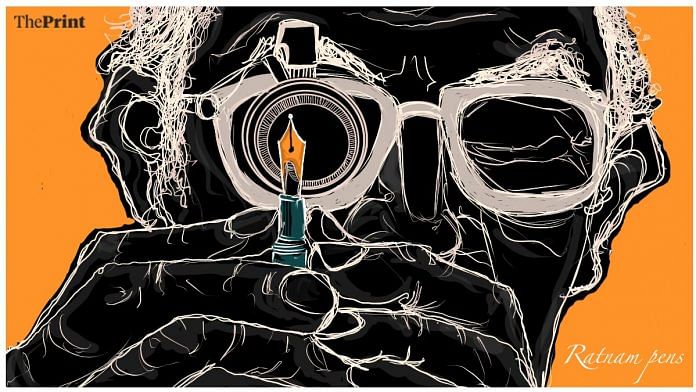On Fort Gate Street in Andhra Pradesh’s Rajahmundry, a small, traditional house stands tall. Serving as a workshop, its board reads, ‘Pioneers of Pen Industry in India since 1932, K.V. Ratnam & Sons, Ratnam Ball Pen Works, Mfrs: Swadeshi ‘Ratnamson’ pens, 14 CT-Gold Nibs’.
When German Chancellor Angela Merkel visited India in November, Prime Minister Narendra Modi gifted her a Ratnam pen along with a handloom woollen khadi stole from Ladakh.
Ratnam Pen Works, named after founder K.V. Ratnam, has, since its inception in 1932, symbolised India’s swadeshi movement led by Mahatma Gandhi.
With a fascinating origin story, the pen has more than just monetary value. It is believed that this pen was used by many greats in Indian history, including leaders like Gandhi, Jawaharlal Nehru, Rajendra Prasad, Indira Gandhi and V.V. Giri, Ramnath Goenka of the Indian Express and Archibald Nye, Governor of Madras. In fact, fountain pens inscribed with the names of the sitting prime minister and president are sent to their residences every five years.
Mahatma Gandhi and the Swadeshi pen
The story behind Mahatma Gandhi and this pen is what gave it the tag of ‘swadeshi‘. Gandhi was not a man who liked to pose. Gopalkrishna Gandhi, his grandson, once wrote “if his working hand were to be imagined, it would be at the spinning wheel or in the act of writing.” It is believed that he wrote 31,000 letters in his lifetime. Which is why in most of his pictures, he is seen doing one of the two activities.
It is known that during India’s freedom struggle, Mahatma Gandhi encouraged the use of products manufactured in India. When he met K.V. Ratnam in 1921, he advised him to make a product using solely Indian components. “He asked Gandhiji, what is the item I have to make [sic] and was told, you can make anything from a pin to a pen,” said K.V. Ramana Murthy, Ratnam’s son. Thus began the legacy of Ratnam Pen Works.
In 1933, after meticulously breaking down a fountain pen and studying its intricacies, Ratnam sent Gandhi a pen he made, only to face rejection. Given its raw components were imported, it fell short of the requirements put forth by Gandhi — the pen was not truly ‘Indian’. A year later, after J.C. Kumarappa, secretary of the All India Village Industries Association, visited Rajahmundry and decided to help Ratnam in his venture, the ‘swadeshi‘ pen was created.
Thanking Ratnam for his efforts, Gandhi wrote him a note which said, “Dear Ratnam… I have used the fountain pen and it seems to be a good substitute to the foreign pen one sees in the bazaar.” This note sits proudly in Ratnam Ball Pen Works even today.

Also read: CDs & DVDs killed the VCR — but not before it gave Indians Hollywood, porn and memories
Hand-made ebonite pens
In 1958, after K.V. Ratnam and his brother Kasuri Satyanarayana split, the business was also divided — into Ratnamsons and Ratnam Ball Pen Works. Shiva Ratnam, Satyanarayana’s grandson said, “We don’t advertise or hype ourselves. The quality of our penmanship speaks for itself.” But not before adding that Gandhi’s note is found in their shop, Ratnam Ball Pen Works, and not the other.
The attention to detail seen in the hand-made ebonite pens was such that nibs of each pen were bespoke for different professions. For a journalist, the nib was modified in such a way that it was possible to write from any angle. Meanwhile, a doctor’s fountain pen had a thicker nib.
“All our pens are handmade and it takes two to three days to make a pen,” said Ramana Murthy, while the 22-carat gold pen takes three days.
A steel-nibbed pen can cost from Rs 150 to Rs 1,500, while one with a 14-carat nib ranges from Rs 2,500 to Rs 15,000. A silver pen with a 14-carat nib costs Rs 25,000 to Rs 35,000 and a gold pen costs a whopping Rs 2 lakh.
In 2012, the India Book of Records recognised K.V. Ramana Murthy for making the smallest pen — 3.5 cm in length and 1.7 gm in weight. It also had a 14-carat gold nib complete with a pen point, clip and ring band.
Also read: Charminar — the ‘rugged’ cigarettes that promoted toxic masculinity




It would be my great pleasure to a Ratnam Pen